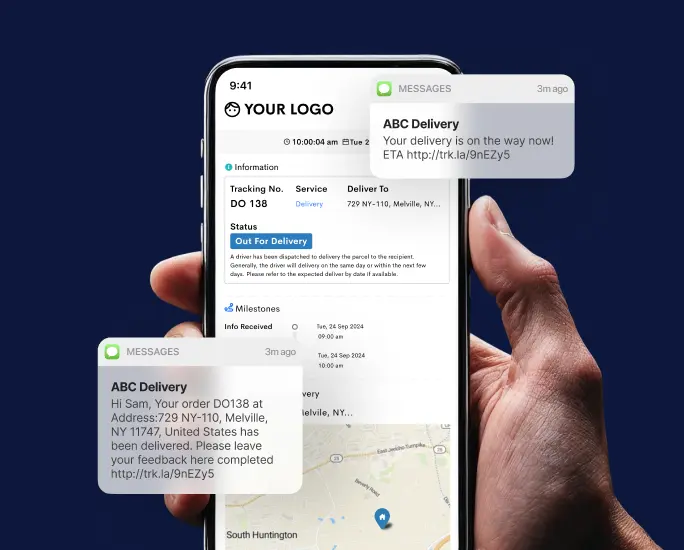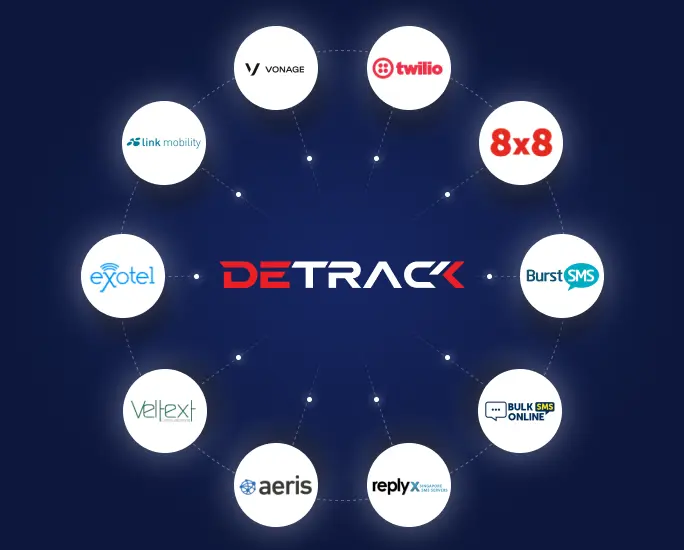Supply chains are the backbone of businesses across various industries. However, recent times have witnessed a surge in supply chain bottlenecks, causing disruptions and challenges for companies worldwide.
These bottlenecks, stemming from diverse factors, have significantly impeded the smooth flow of goods and services, posing considerable hurdles for businesses aiming for efficiency and growth.
This blog explores the root causes of supply chain bottlenecks and offers practical strategies to overcome these challenges. By understanding these issues and implementing innovative solutions, businesses can strengthen their supply chains, improve resilience, and thrive in a dynamic market environment.
Turn Fulfillment Frustrations into Streamlined Operations
Experience real-time tracking, efficient routing, and prompt order fulfillment for higher customer satisfaction with Detrack!
What are Supply Chain Bottlenecks?
Supply chain bottlenecks encompass various points of congestion or slowdowns that disrupt the seamless flow of goods, materials, or services within the supply chain. These bottlenecks arise due to myriad factors spanning different stages of the supply chain process.
Issues such as shortages in raw materials caused by natural disasters or unexpected surges in demand, labor disruptions, transportation delays, capacity limitations in warehouses, supplier-related problems, and fluctuations in consumer demand contribute to these obstacles.
For instance, a shortage of critical components can halt production, while congestion at ports or transportation bottlenecks can delay the delivery of finished products. Identifying and addressing these bottlenecks are pivotal for businesses aiming to maintain operational efficiency and meet customer expectations.
Strategies to mitigate these challenges often involve diversifying suppliers, adopting technology for better visibility and coordination, implementing agile practices, and fostering resilience to navigate uncertainties effectively.
Types of Supply Chain Bottlenecks
Production Bottlenecks
Production bottlenecks occur when there’s an imbalance in the pace of different processes within the production line. For instance, if one stage of the manufacturing process operates more rapidly than another, it can lead to a buildup of materials.
This imbalance causes delays further down the line as excessive materials accumulate and disrupt the workflow. Such bottlenecks demand a synchronized and balanced approach across all production stages to ensure smooth continuity without undue build ups or slowdowns.
Supply Chain Bottlenecks
Supply chain bottlenecks often stem from issues related to supplier material flow. These can result from poor inventory management, frequent changes in product specifications, or financial constraints affecting suppliers.
When suppliers face challenges in meeting demand due to these issues, it disrupts the supply chain. Such bottlenecks necessitate stronger supplier relationships, improved communication, and strategic inventory planning to prevent interruptions in the flow of materials and components.
Inventory Management Bottlenecks
Improper inventory management can cause bottlenecks in various forms. Excessive inventory ties up capital, occupies storage space, and can become obsolete or damaged. On the other hand, inadequate inventory levels or stockouts can disrupt operations, leading to delays and customer dissatisfaction.
Effective inventory management strategies, including accurate demand forecasting, optimized ordering, and inventory control measures, are crucial to maintaining a balanced inventory level and preventing these bottlenecks.
Transportation Bottlenecks
Transportation bottlenecks occur when there are inefficiencies or inadequacies in the movement of goods from one point to another within the supply chain. Delays in shipping, congestion at ports or hubs, limited transport capacities, or suboptimal route planning can all hinder the timely delivery of goods.
These bottlenecks highlight the importance of optimized logistics, efficient transportation modes, and contingency plans to mitigate disruptions in the supply chain caused by transportation-related issues.
Information Bottlenecks
Information bottlenecks arise from a lack of timely, accurate, or accessible data within the supply chain. When decision-makers don’t have the necessary information to make informed choices, it can lead to operational delays, suboptimal decisions, and inefficient resource allocation.
Implementing robust information systems, improving data sharing among supply chain partners, and utilizing real-time analytics are essential in overcoming these bottlenecks, enabling better decision-making and streamlined operations.

The Impact of Bottlenecks on Businesses
Supply chain bottlenecks profoundly impact businesses, manifesting in various disruptions across industries. These bottlenecks, often stemming from production, inventory management, transportation, and information gaps, significantly impede operational fluidity.
Industry experts have highlighted the repercussions of these bottlenecks. Michael Zimmerman from A.T. Kearney underscores the need for resilience, predicting strategies like multi shoring and increased inventory.
Andre Simha emphasizes the acceleration of digitalization in response to supply chain challenges, emphasizing the need for multi-platform engagement. These expert views accentuate the necessity for adaptive strategies to counter bottlenecks.
Beyond expert insights, statistics illuminate the tangible impact of these bottlenecks. Reports indicate that geopolitical instability is anticipated to affect the supply chains of over 60% of global organizations in the coming years.
Moreover, cybersecurity remains a significant concern for nearly half of these businesses, highlighting vulnerabilities within supply chain networks. Additionally, 71% of global companies view raw material costs as the primary threat to their supply chains in the foreseeable future.
The cumulative effect of these bottlenecks necessitates proactive measures and strategic adaptations. Addressing production, inventory management, transportation inefficiencies, and information gaps emerges as pivotal in mitigating disruptions.
Businesses must foster resilience through diversified strategies and leverage digital solutions to navigate the complex landscape posed by supply chain bottlenecks.
7 Common Causes of Supply Chain Bottlenecks
Delays from Suppliers
Delays from suppliers can arise due to various reasons such as unforeseen circumstances, transportation issues, or production constraints on their end. These delays have a cascading effect, disrupting production schedules, causing inventory shortages, and impacting customer orders.
Effective communication during disruptions is critical, as it helps manage customer expectations and minimizes dissatisfaction. Failing to provide clear explanations or alternatives during delays can lead to customer concern, erode trust, and damage overall customer experience (CX), which can have long-term repercussions on brand loyalty.
Reliance on Single Suppliers
Relying solely on a single supplier exposes the supply chain to considerable risks. Geopolitical tensions, natural disasters, or incidents like the Suez Canal blockage highlight the vulnerabilities of depending on a sole source.
Diversifying the supplier base and establishing relationships with alternative suppliers can mitigate these risks, ensuring a more resilient supply chain that can better withstand disruptions.
Customs and Trade Barrier Issues
Global supply chains are subject to diverse customs regulations, trade tariffs, and regulatory complexities across borders. These issues often lead to delays, increased transportation costs, and administrative burdens.
Businesses navigating these barriers must invest in strategies that facilitate smoother customs processes and comply with diverse regulations to minimize these interruptions.
Poor Visibility Across Supply Chain
Inadequate visibility across the supply chain presents challenges in monitoring inventory levels, supplier performance, or shipment tracking. This lack of transparency can lead to inefficiencies, excess inventory, stockouts, and difficulties in making informed decisions promptly.
Investing in technologies like IoT, RFID, or supply chain management systems can improve real-time visibility, allowing for better planning and decision-making.
Digitalization Deficiency
Despite the potential benefits, many supply chains remain digitally underdeveloped. Low digitization levels limit the adoption of advanced technologies like AI, machine learning, and predictive analytics, which can optimize processes, automate tasks, and improve collaboration among supply chain partners.
Increasing digital capabilities across the supply chain is crucial for enhancing operational efficiency and responsiveness to market changes.
Inaccurate Demand Forecasting
Demand forecasting errors can lead to substantial disruptions in supply chain planning. Inaccurate predictions may result in excess inventory, tying up capital and storage space, or lead to stockouts, causing customer dissatisfaction.
Leveraging advanced analytics, historical data, market trends, and customer insights can improve forecasting accuracy, aiding in better inventory management and production planning.
Inadequate Technology Investment
Limited investment in technology hampers the adoption of innovative solutions that could optimize supply chain operations. Prioritizing cost reduction over digitization might hinder the implementation of technologies crucial for collaboration, data analytics, and process automation.
Increasing investments in digital tools, supplier relationship management systems, and advanced analytics can empower businesses to streamline operations and drive efficiencies across the supply chain ecosystem.

10 Steps to Future Proof Against Supply Chain Bottlenecks
Improving Supply Chain Visibility
Enhancing supply chain visibility is a pivotal step in ensuring effective decision-making and responsiveness.
Real-time tracking and notification systems, such as Detrack, offer radical visibility that enables companies to promptly manage disruptions with agility and resilience.
These platforms facilitate immediate notifications of potential delays, empowering proactive solutions that enable products to reach customers reliably and swiftly. Such enhanced visibility not only mitigates risks but also enhances customer satisfaction and trust by ensuring consistent and timely delivery.
Diversifying Supplier Base
Reducing dependency on a single supplier is a strategic move that helps mitigate risks associated with disruptions.
Cultivating relationships with multiple suppliers across different geographic locations fortifies the supply chain against unforeseen events that might impact a single source. This strategy ensures a more resilient supply chain that can navigate through unexpected challenges without significant disruptions to operations.
The involvement of various suppliers allows businesses to maintain a steady flow of materials or components, preventing bottlenecks caused by disruptions in one supply source.
Investing in Technology and Digitalization
Embracing technological advancements and digital tools, such as Detrack, empowers supply chains with automation, real-time data analytics, and streamlined processes. Digitization facilitates better collaboration, enhances operational efficiency, and enables faster and more informed decision-making.
Platforms like Detrack offer comprehensive solutions that leverage digitalization to provide real-time insights, enabling proactive measures to address potential disruptions effectively.
With features like real-time tracking, analytics, and reporting, Detrack optimizes logistics operations and provides actionable data for making informed decisions in the face of disruptions.
Developing a Risk Management Strategy
Establishing a comprehensive risk management strategy is crucial for proactively managing supply chain disruptions. This involves identifying potential threats, creating contingency plans, and regularly assessing vulnerabilities within the supply chain.
Mapping risks and formulating mitigation plans contribute to proactively managing disruptions, allowing businesses to respond swiftly and effectively to unforeseen events.
This comprehensive approach minimizes the impact of disruptions and builds resilience, ensuring continuity in operations during challenging times.
Enhancing Communication and Collaboration
Effective communication and collaboration among stakeholders within the supply chain ecosystem is essential for seamless operations. Clear and timely communication fosters better coordination, improves responsiveness, and helps resolve issues swiftly.
Building strong relationships and fostering open communication channels among suppliers, logistics partners, and internal teams ensure that everyone is aligned, informed, and prepared to tackle disruptions efficiently.
This collaborative approach creates a cohesive network that can quickly adapt to changing circumstances and address challenges effectively.
Optimizing Inventory Levels
Balancing inventory levels is critical to prevent excess stock or stockouts. Utilizing data-driven demand forecasting and inventory management systems aids in maintaining optimal stock levels, reducing storage costs, and enhancing responsiveness.
Efficient inventory management practices enable businesses to anticipate demand fluctuations and adjust their inventory levels accordingly, ensuring they can meet customer demands while minimizing unnecessary inventory holding costs.
Monitoring and Analyzing Supply Chain Performance
Regular monitoring and analysis of supply chain performance metrics enable businesses to identify inefficiencies, bottlenecks, and areas for improvement. This data-driven approach facilitates continuous optimization and informed decision-making.
By closely monitoring key performance indicators (KPIs) across various supply chain stages, companies can proactively identify areas that require attention and take corrective measures to streamline operations, enhance efficiency, and improve overall performance.
Adopting Agile and Flexible Supply Chain Models
In today’s dynamic and uncertain business environment, adopting agile and flexible supply chain models is imperative. Creating supply chain models that are agile and adaptable allows for quick adjustments in response to market changes or disruptions.
Flexibility in operations enables the supply chain to swiftly adapt to unforeseen circumstances, ensuring operational resilience.
Implementing agile methodologies and flexible processes empowers businesses to pivot quickly when faced with disruptions, enabling them to maintain continuity and minimize the impact on their operations.
Upskilling and Training Workforce
Investing in workforce training and development programs is essential to equip employees with the necessary skills and knowledge to navigate evolving technologies and changing supply chain dynamics.
Continuous learning and development foster adaptability and innovation within the workforce. By providing opportunities for skill enhancement and knowledge acquisition, companies can create a well-prepared workforce to tackle the challenges of a rapidly evolving supply chain landscape.
Training programs that focus on technological proficiency, problem-solving skills, and adaptability are instrumental in preparing the workforce for the future of supply chain management.
Engaging in Sustainable and Ethical Practices
Integrating ethical and sustainable practices throughout the supply chain is essential for long-term viability and resilience. Promoting social sustainability involves ensuring fair labor practices, human rights, health, safety, and ethical conduct across the supply chain.
Businesses that prioritize sustainability and ethical considerations contribute positively to society and the environment and mitigate risks associated with potential reputational damage.
Furthermore, a culture shift towards sustainable practices fosters resilience and long-term viability within the supply chain, aligning with the evolving expectations of consumers and stakeholders.

Learning from the Best: How Leading Companies Tackled Bottlenecks
Nike’s Supply Chain Innovation
Nike, renowned for its athletic footwear and apparel, faced challenges with production delays and disruptions in their supply chain. They implemented a strategy focusing on digitalization and advanced analytics to combat this.
Nike invested heavily in predictive analytics, leveraging real-time data to forecast demand more accurately, thus optimizing inventory levels. By embracing technology and data-driven decision-making, Nike managed to minimize bottlenecks and enhance their supply chain efficiency.
Walmart’s Supplier Collaboration
Walmart, a global retail giant, aimed to tackle inventory inefficiencies and delays stemming from its extensive supplier network. Walmart introduced a Vendor Managed Inventory (VMI) system, allowing suppliers direct access to its inventory data.
Through this collaboration, suppliers gained real-time insights into Walmart’s stock levels, enabling them to manage inventory more effectively. This proactive approach streamlined the supply chain, reducing stockouts and optimizing inventory turnover across Walmart’s stores.
Amazon’s Fulfillment Center Optimization
Amazon faced challenges in managing its vast network of fulfillment centers, especially during peak demand periods. The company implemented robotics and automation in its warehouses to enhance efficiency and speed.
Using robots for tasks like picking and packing accelerated order fulfillment while minimizing errors. Additionally, Amazon employed sophisticated algorithms and AI-driven technologies for demand forecasting, allowing them to anticipate customer needs better. These innovations significantly reduced bottlenecks in their supply chain operations.
Toyota’s Lean Manufacturing Principles
Toyota revolutionized the automotive industry with its lean manufacturing principles. The company focused on minimizing waste, improving processes, and fostering a culture of continuous improvement.
Through the adoption of practices like Just-In-Time (JIT) inventory management and Kaizen methodologies, Toyota streamlined its supply chain, reducing inventory holding costs and enhancing production efficiency. This lean approach enabled Toyota to swiftly respond to market changes and minimize disruptions.
Your Roadmap to a Bottleneck-Free Supply Chain
Supply chain bottlenecks represent formidable barriers in the journey of businesses, impeding the smooth flow of goods and services. However, proactive measures and strategic foresight can fortify supply chains against these hurdles.
Overcoming these challenges requires a multifaceted approach. Additionally, leveraging solutions like Detrack, offering real-time visibility into supply chains, aids in swift adaptations and agile decision-making.
Detrack offers a cutting-edge platform that enhances supply chain visibility through real-time tracking and monitoring capabilities. Its user-friendly interface empowers businesses with immediate notifications of potential delays or issues along the supply chain.
Detrack’s agile system enables companies to proactively manage their logistics and pivot swiftly and efficiently in response to unforeseen disruptions. By providing immediate insights into delivery statuses, Detrack assists in making informed decisions and executing agile strategies to minimize delays and maintain operational efficiency.
Turn Fulfillment Frustrations into Streamlined Operations
Experience real-time tracking, efficient routing, and prompt order fulfillment for higher customer satisfaction with Detrack!












